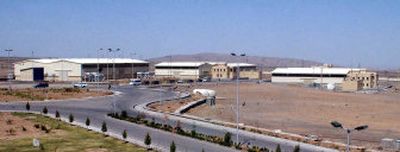Iran removes seals on nuclear facility

LONDON – Global criticism rained down on Iran on Tuesday after it broke seals set by the International Atomic Energy Agency on a nuclear enrichment facility in Natanz, ending a two-year freeze on activities that Western leaders fear could lead to the enrichment of uranium to build nuclear weapons.
In response, European ministers scheduled an urgent meeting for Thursday to determine whether to recommend that Iran face proceedings before the U.N. Security Council that could result in economic sanctions.
Several governments said the action by Iran’s new hard-line government led by President Mahmoud Ahmadinejad was unnecessary and provocative. While the Islamic republic has insisted that it intends to use nuclear energy to operate only power generating plants, nations including the United States are convinced that Iran plans the research in order to develop nuclear weapons.
While breaking the seals is not, in and of itself, an illegal act, the International Atomic Energy Agency, using its strongest language to date, voiced “serious concern” at Iran’s action. The IAEA is the body that oversees adherence to the Nuclear Non-Proliferation Treaty.
“There is no good reason why Iran should have taken this step,” said Foreign Minister Jack Straw of Britain, one of the three European countries negotiating with Iran to limit its nuclear program on behalf of the European Union.
Scott McClellan, the White House press secretary, called the move a “serious escalation” and said that if Iran “continues down this road and the negotiations have run their course, then there is only one option to pursue, and that is referral to the Security Council. And that is the option we are talking about with our European friends and others.”
The Iranian action caps a steadily rising war of nerves in recent months between Tehran, the Iranian capital, and an international community alarmed at the prospect that a militantly anti-Western and anti-Israeli regime could be on course to obtain a nuclear weapon. Iran has acknowledged that it is working on missile technology that could deliver warheads as far as Israel and Western Europe.
Iran last week announced it intended to resume nuclear research frozen two years ago, although it continued to insist that its program is peaceful and legal under international conventions, and that it has a right to pursue nuclear power generating plants and the fuel that runs it.
“What we resume is merely in the field of research, not more than that,” the deputy head of the Atomic Energy Organization of Iran, Mohammad Saeedi, told a news conference on Tuesday.
“Production of nuclear fuel” – which would involve enrichment – “remains suspended,” he said.
But outside Iran, there was little inclination to give the Iranians the benefit of the doubt.
Since Ahmadinejad’s election in June, Iran has defied the international community by beginning preliminary efforts to process yellowcake uranium into uranium gas. Until now, Iran had not taken the next step of enriching the material, which could be used in either an energy or arms program.
On Tuesday, according to the IAEA, Iranian officials said they plan to feed uranium hexafluoride gas made from uranium yellowcake into a centrifuge cascade at Natanz to be spun into enriched uranium, in a small-scale pilot enrichment program.
While experts say that with the cascade of 164 machines it would take 10 years to manufacture enough enriched uranium to make a bomb, Western countries worry that once the Iranians master the process they could switch over to larger scale production.